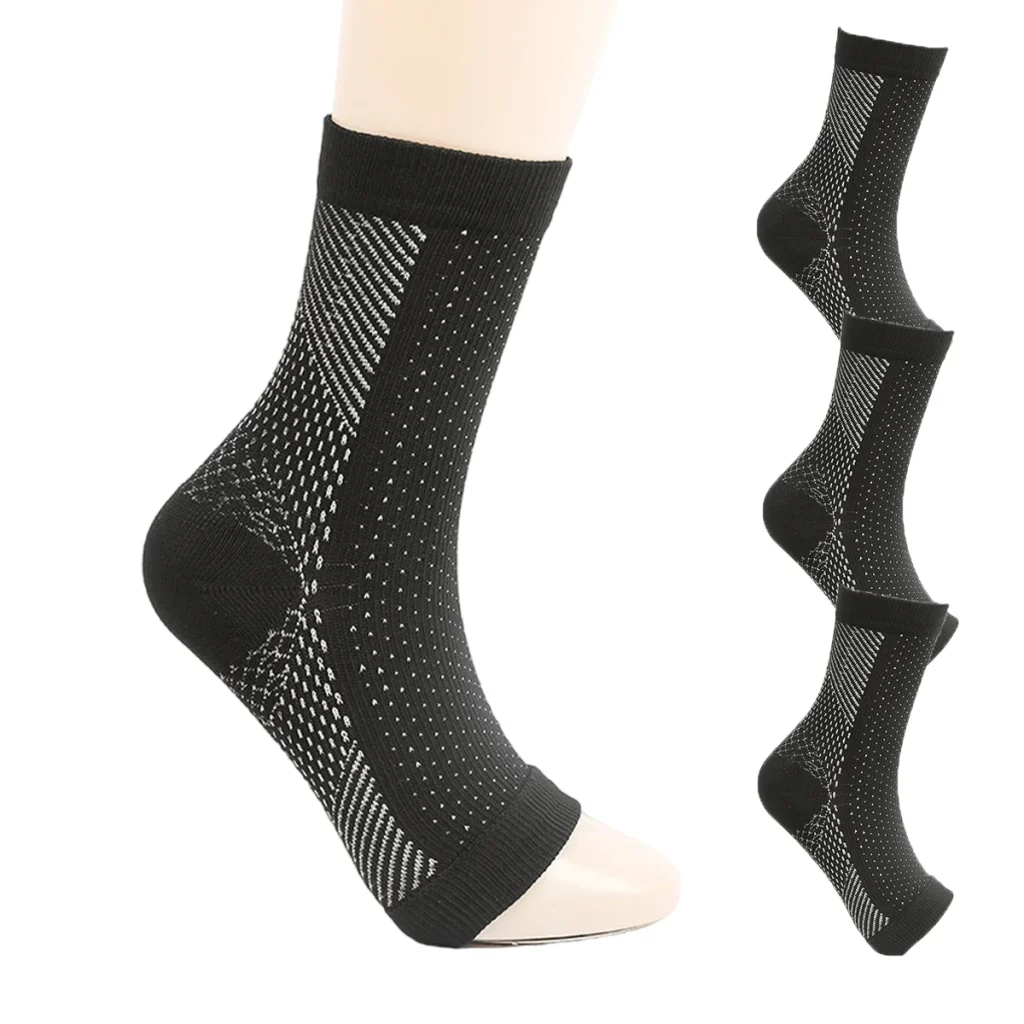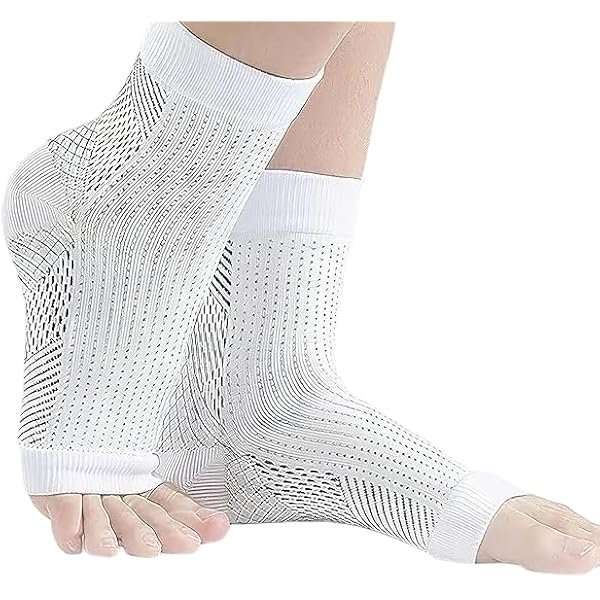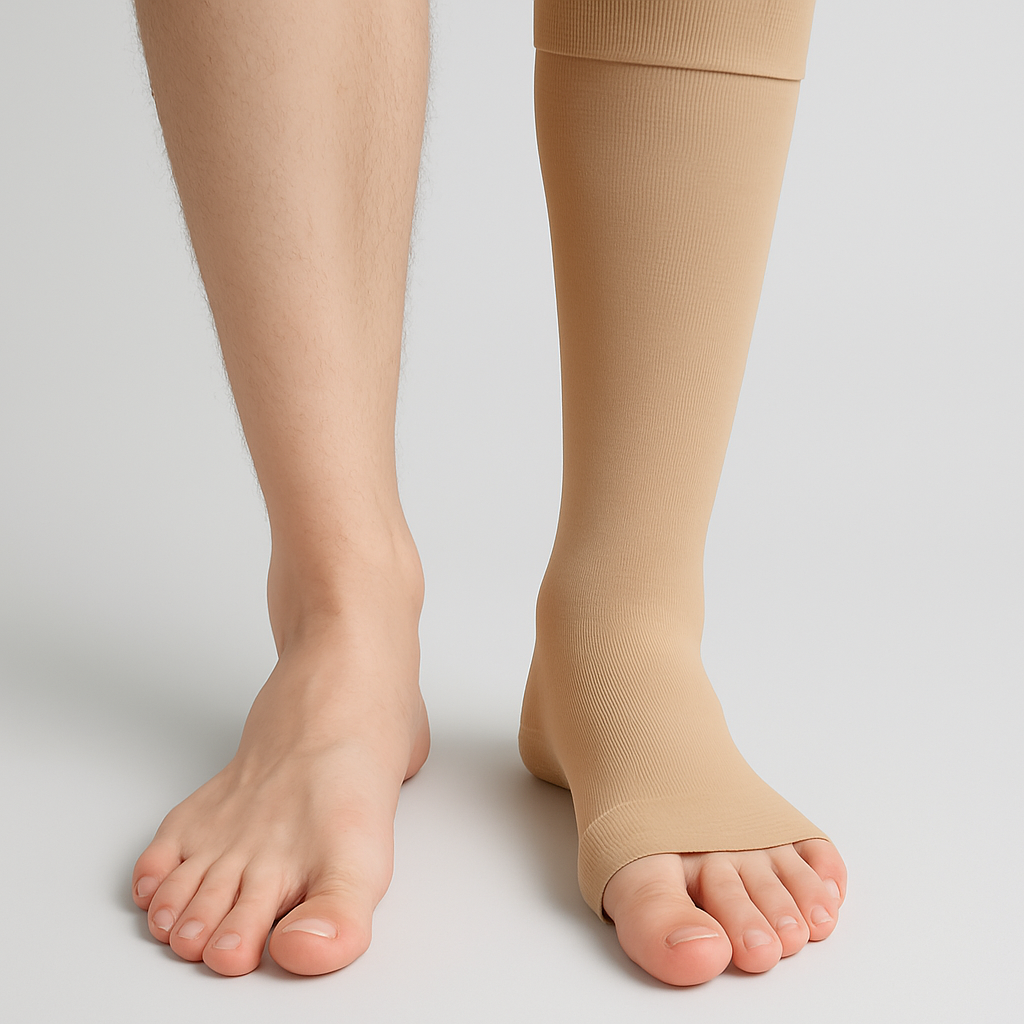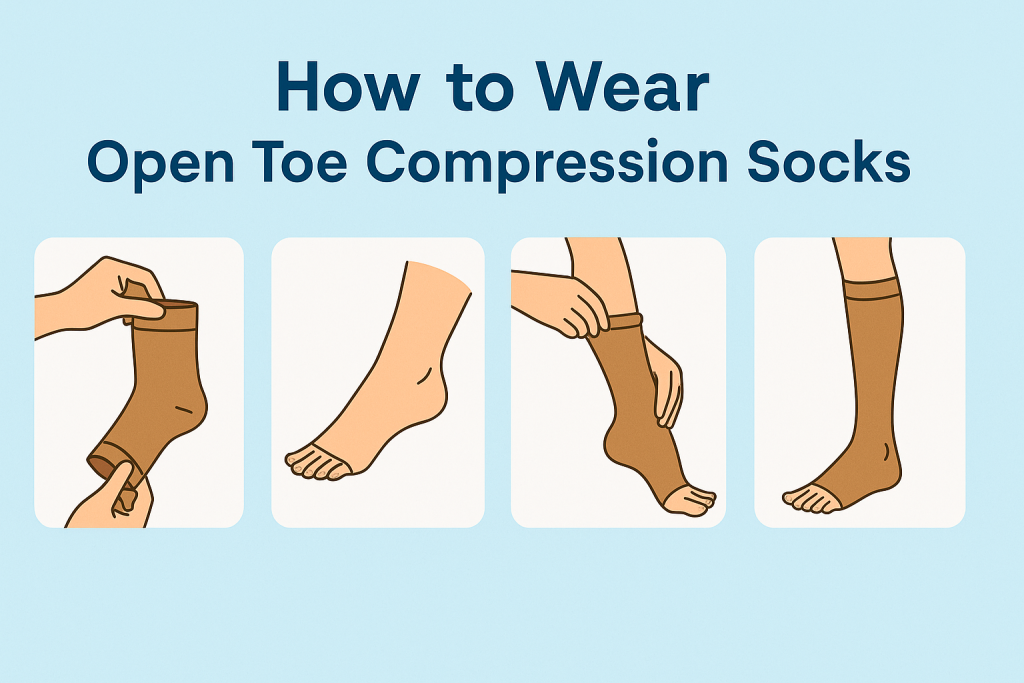Neuropathy socks have open toes to enhance breathability and comfort for individuals with sensitive feet. This design allows for better airflow, reducing moisture and irritation.
Neuropathy can cause various symptoms, including tingling, numbness, and pain in the feet. Those affected often seek comfortable solutions to manage these issues. Neuropathy socks are specifically designed to provide relief and support. The open-toe feature allows wearers to feel more at ease while maintaining necessary protection.
These socks are often made from soft, non-binding materials that prevent constriction. This design helps improve blood circulation, essential for neuropathy patients.
Choosing the right socks can significantly impact daily comfort and overall foot health. Understanding these benefits can guide individuals in selecting the most suitable footwear for their needs.
Introduction To Neuropathy And Foot Health
Neuropathy affects many people, causing pain and discomfort. It is important to choose the right footwear. Proper shoes can help reduce foot problems.
Neuropathy socks with open toes offer several benefits. They provide breathability and prevent overheating. Open toes allow for better circulation and reduce pressure on sensitive areas.

Many people with neuropathy experience numbness or tingling. Open-toe socks help to keep feet cool. They also prevent blisters and other skin issues.
Choosing the right socks is essential for foot health. Look for options that are soft and stretchy. This ensures a comfortable fit without tightness.
Neuropathy Socks: A Closer Look
Neuropathy socks are designed to provide comfort for those with nerve pain. One unique feature is their open-toe design. This allows for better air circulation and helps keep feet cool.
These socks use special materials like cotton, bamboo, and spandex. These fabrics are soft and stretchy, ensuring a comfortable fit. The socks also offer padding in key areas to reduce friction.
The non-binding tops prevent constriction. This is important for those with sensitive skin. They can help to improve blood flow, which is vital for healing.
The Open-Toe Design
The open-toe design of neuropathy socks offers many advantages. It provides better breathability, keeping feet cool and dry. People with neuropathy often suffer from sensitivity. Open-toe socks can reduce discomfort by allowing feet to feel less constricted.
These socks also promote better circulation. Improved blood flow helps in reducing numbness and tingling sensations. Open-toe socks make it easier to check for any foot issues, like blisters or redness. This can be vital for diabetic patients.
Overall, the open-toe feature enhances comfort and functionality for those with neuropathy. It supports foot health while ensuring a snug yet flexible fit.
Enhancing Comfort For Sensitive Feet
Neuropathy socks often feature open toes to enhance comfort for sensitive feet. This design helps to alleviate pressure points. People with neuropathy can experience discomfort from tight footwear.

Open-toe socks allow for better airflow. This keeps the feet cool and dry, reducing the risk of blisters. Improved blood circulation is another key benefit. These socks provide gentle support without restricting movement.
Comfortable feet lead to a better quality of life. Choosing the right socks can make a big difference. Look for materials that are soft and breathable. Investing in neuropathy socks can be a simple solution to foot discomfort.
Preventing Complications
Neuropathy socks with open toes help prevent complications. They reduce the risk of infections by allowing better air circulation. Open toe designs keep feet cool and dry. This is important for people with sensitive skin or diabetes.
These socks also help in reducing swelling and irritation. They fit snugly without being too tight. This design allows for comfortable movement. A better fit means less rubbing against the skin.
| Benefit | Description |
|---|---|
| Prevents Infections | Improves air flow, keeping feet dry. |
| Reduces Swelling | Snug fit without tightness. |
| Comfortable Movement | Less rubbing, more freedom. |
User Experiences
Many users share their positive experiences with neuropathy socks. They appreciate the open toe design for comfort. This style allows better breathability and keeps feet cool.
Some find traditional socks too tight. They can feel uncomfortable and restrict blood flow. Neuropathy socks provide a looser fit. Users feel less pressure on their feet, which helps reduce pain.
Feedback shows a common theme: comfort and relief. Users often mention how these socks improve their daily activities. They enjoy walking and standing without discomfort.
Choosing The Right Neuropathy Socks
Choosing the right neuropathy socks is essential for comfort. Open-toe designs allow for better air circulation and reduce moisture. This feature can help prevent fungal infections and keep feet dry.
Consider the material when selecting socks. Look for breathable fabrics like cotton or bamboo. These materials provide better cushioning and support for sensitive feet.
Compression levels are also important. Some socks offer gentle compression, promoting better blood flow. This can ease discomfort and swelling.
| Brand | Model | Features |
|---|---|---|
| Dr. Scholl’s | Diabetic Socks | Moisture-wicking, open toe |
| Futuro | Compression Socks | Soft, breathable, cushioned |
| Sigvaris | Comfort Socks | Graduated compression, open toe |
Care And Maintenance Tips
Taking proper care of your neuropathy socks ensures they stay effective and comfortable over time. These specialized socks are designed with sensitive feet in mind, so handling them gently is essential to preserve their unique features.

Washing Instructions
When it comes to cleaning neuropathy socks, gentle treatment is key. Always wash them in cold water. Cold temperatures help maintain the elasticity of the fibers and prevent premature wear. Hot water, on the other hand, can cause the fabric to break down more quickly.
Use a mild, gentle detergent that is free from harsh chemicals. Strong detergents can strip away the sock’s protective qualities, reducing their ability to provide comfort and support.
Avoid bleach and fabric softeners at all costs. Bleach can severely damage the fibers, leading to thinning or tearing. Fabric softeners, while they may seem helpful, can actually coat the fibers and reduce the breathability and moisture-wicking properties that are vital for neuropathy socks.
Whenever possible, hand washing is the safest method. Gently soak and lightly rub the socks, ensuring they are cleaned without being stretched or twisted out of shape. If you must use a washing machine, place the socks in a mesh laundry bag and select a delicate or gentle cycle.
Drying Recommendations
Proper drying methods are just as important as washing. Avoid machine drying, as the intense heat from dryers can shrink or damage the fabric, impacting the fit and effectiveness.
Instead, lay the socks flat on a clean, dry towel. Allow them to air dry naturally, away from direct sunlight or heaters. Sun exposure and high temperatures can weaken the fibers and cause fading or hardening of the fabric, making the socks less comfortable for sensitive feet.
By laying them flat, you help maintain their original shape, ensuring they continue to offer the intended support around the foot and ankle.
Tips to Prolong Sock Life
Extending the lifespan of your neuropathy socks comes down to mindful habits:
- Rotate your socks: Don’t wear the same pair every day. Rotate among several pairs to reduce stress and wear on any single pair.
- Proper storage: Keep your socks in a cool, dry place. Avoid humid areas like bathrooms, and keep them out of prolonged direct sunlight.
- Inspect regularly: Take the time to check for small holes, frayed areas, or worn spots. Repairing small damage early prevents it from becoming a bigger problem later.
Neuropathy socks are an investment in your foot health. Treating them with care ensures you get the most out of their supportive and protective qualities. By following simple care and maintenance practices, you’ll enjoy better comfort, improved support, and longer-lasting wear from each pair.
Are Open Toe Compression Socks Effective?

Open toe compression socks are just as effective as closed toe versions when used properly. They provide graduated compression that helps improve blood circulation, reduce swelling, and prevent blood clots. The only difference lies in the design: open toe socks allow the toes to be exposed.
Many individuals prefer open toe compression socks because they offer:
- Better ventilation: Ideal for warmer climates or people who feel discomfort with enclosed toes.
- Ease of use: Easier to put on and adjust, especially for those with sensitive toes or bunions.
- Flexibility: They can be worn with sandals or flip-flops, making them more versatile for casual use.
In terms of medical benefits, both open and closed toe compression socks deliver the same therapeutic pressure, measured in mmHg (millimeters of mercury), to promote circulation.
Can You Cut the Toes Out of Compression Stockings?
Compression stockings are medical-grade garments designed with precision to apply graduated pressure, helping to improve blood circulation in the legs. While it might seem like a simple solution to cut the toes off for more comfort, doing so is strongly discouraged. Here’s why:
Disrupts the Pressure Gradient
Compression stockings are engineered to deliver graduated pressure, meaning the pressure is strongest at the ankle and gradually decreases up the leg. This specific design is crucial for promoting healthy blood flow back toward the heart.
When you cut the toe area, you interfere with the way pressure is distributed, potentially rendering the stockings medically ineffective. Instead of supporting your veins, the stockings may fail to provide the necessary compression where it’s needed most.
Increases Risk of Fraying and Damage
The fabric used in compression stockings is specially woven to maintain elasticity and structure under constant tension. Cutting the toes off exposes raw edges, which can easily fray, unravel, or weaken over time.
Even if you try to hem or reinforce the area afterward, it’s difficult to restore the original integrity of the material, leading to early wear and tear and a much shorter lifespan for the stockings.
Compromises Fit and Comfort
Proper fit is essential for compression therapy. When you alter the design by cutting, the stockings may lose their snug fit, causing them to:
- Roll down at the edges
- Slide off during movement
- Bunch up uncomfortably under shoes
A poor fit not only reduces the effectiveness of the compression but can also cause skin irritation or even worsen circulation problems.
Better Alternatives: Open Toe Compression Stockings
If you find traditional closed-toe compression stockings uncomfortable—especially in warmer weather or if you have sensitive toes—there is a safer solution:
Professionally manufactured open toe compression stockings are designed to offer all the medical benefits while leaving your toes free. They maintain the proper graduated compression, support your veins, and ensure durability and comfort without risking damage.
Open toe stockings are particularly recommended for:
- Those who prefer more ventilation during hot weather
- People with bunions, hammertoes, or other toe issues
- Patients recovering from foot surgeries
Side Effects of Wearing Compression Stockings
Compression stockings are generally safe, but improper use can cause side effects. Common issues include:
- Skin Irritation: Tight stockings can cause redness, itching, or rashes.
- Numbness: Wearing the wrong size or too much compression can restrict circulation instead of promoting it.
- Pressure sores: If the stockings bunch up, they can create pressure points, potentially leading to skin breakdown.
- Discomfort: Ill-fitting stockings can cause pain or worsen swelling.
To avoid side effects, ensure you have the correct size, compression level, and fitting instructions from a healthcare provider.
How to Wear Open Toe Compression Socks

Wearing open toe compression socks correctly maximizes their effectiveness. Here’s a step-by-step guide:
Step 1: Prepare the Socks
- Turn the socks inside out up to the heel section.
- Insert your foot into the sock, positioning the toes through the open area.
Step 2: Slide Over the Heel
- Pull the sock gently over your heel, ensuring it fits snugly without wrinkles.
Step 3: Smooth the Fabric
- Gradually roll or slide the sock up your calf.
- Smooth out any folds to avoid pressure spots.
Step 4: Adjust the Toe Opening
- Make sure the open toe section sits comfortably without cutting into your toes.
- Toes should have free movement and feel neither pinched nor overly tight.
Tips for Best Results:
- Apply socks first thing in the morning when swelling is minimal.
- Use rubber gloves to get a better grip when putting them on.
- Avoid lotion before wearing, as it can make sliding the socks difficult.
Open toe compression socks combine the benefits of medical compression with the freedom and flexibility of exposed toes, making them a great option for comfort without sacrificing effectiveness.
Frequently Asked Questions
- Why Choose Open-toe Neuropathy Socks?
Open-toe neuropathy socks provide breathability and comfort, allowing better airflow for sensitive feet.
- Do Neuropathy Socks Improve Circulation?
Yes, neuropathy socks are designed to enhance circulation, reducing swelling and discomfort in the legs and feet.
- Can Open-toe Socks Help With Neuropathy Pain?
Open-toe socks can alleviate neuropathy pain by reducing pressure on sensitive areas and providing gentle support.
- Who Should Wear Neuropathy Socks?
People with diabetes, neuropathy, or circulation issues can benefit from wearing neuropathy socks for added comfort and support.
- Are Neuropathy Socks Machine Washable?
Most neuropathy socks are machine washable, but always check the care instructions for specific washing guidelines.
Conclusion
Understanding why neuropathy socks have open toes highlights the thoughtful design behind them. Open-toe socks promote better circulation, allow the skin to breathe, and reduce pressure on sensitive areas. This feature not only enhances comfort but also helps manage common neuropathy symptoms like swelling, numbness, and overheating. By relieving unnecessary friction and improving airflow, they offer significant daily relief.
Choosing the right neuropathy socks can make a real difference in how you move and feel. Invest in your foot health today for a better tomorrow.
Recent Posts
Soothing Solutions: How To Warm Up Cold Feet From Neuropathy?
To warm up cold feet from neuropathy, try soaking them in warm water or using heated socks. Gentle foot massages also help improve circulation. Cold feet can be a common issue for individuals with...
Discover The Surprising Truth: Can Tight Socks Cause Achilles Pain?
Yes, tight socks can cause Achilles pain. They restrict blood flow and put pressure on the Achilles tendon. Achilles pain is a common issue many people experience. Tight socks can exacerbate this...
